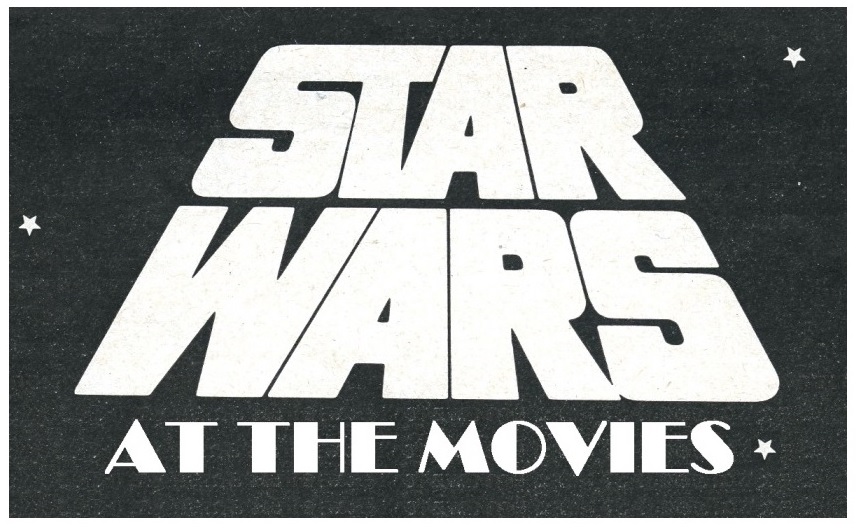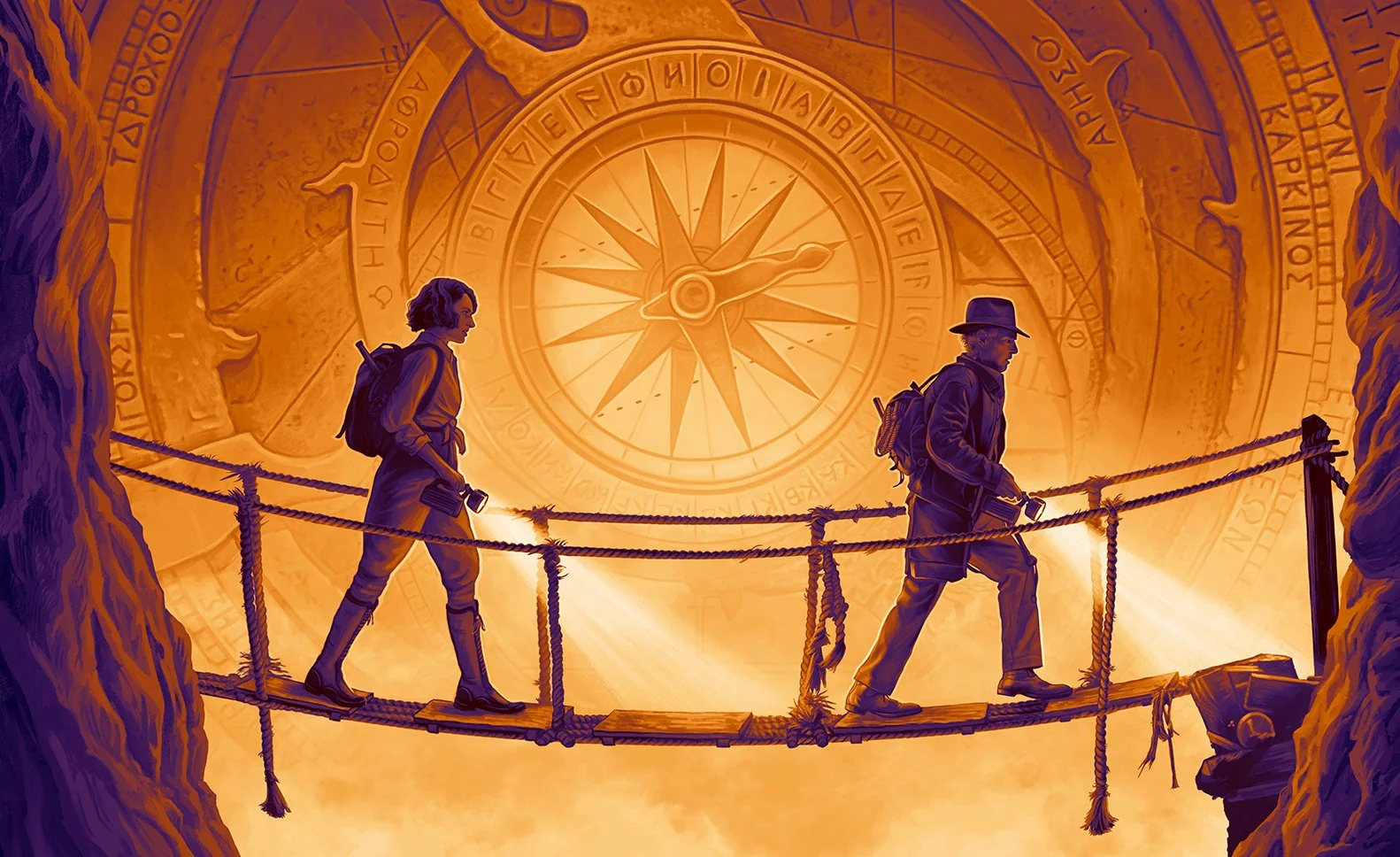THE DIAL OF DESTINY: Going Out with Grit & Grace
Poster Artwork by C.A. Martin
Upon hearing his friend and peer Steven Spielberg had been yearning to do a movie that was “all action and all fun, and very escapist” akin to James Bond, George Lucas recalls having said, “Ah, I’ve got just the thing for you. I happen to have one in my pocket.”
Over 45 years later, Indiana Jones and the Dial of Destiny effectively meets Spielberg’s original mandate but offers plenty more than that to those who’ve grown up and grown older alongside Professor Henry Jones, Jr. (as well as a generation for which this might be their first foray).
While 007 has had many faces and a filmography that’s fivefold, Indy’s legacy is built upon a related though very different model of cinematic success. His vitality emanates directly from Harrison Ford, whose ownership of the role could validly be seen as ego-driven by some. Nevertheless, the actor clearly cares about the character and fundamentally embodies his persona.
Ford, alongside his original collaborators Lucas and Spielberg, almost cared too much given the increasing difficulty and extended gaps in bringing Indiana Jones to the big screen as the years passed, scripts stalled and the studio tentpole landscape changed.
A certain Grail Knight once said, “Long time to wait.” In the case of this 5th installment, it was worth it.
Every contemporary blockbuster could take a lesson in efficiency from Raiders of the Lost Ark and Dial of Destiny is no different. Even so, James Mangold and company have earnestly maintained an old-fashioned sensibility that perhaps doesn’t speak to mass audiences the way it once did. Which is a shame.
The drawn-out (past is) prologue on the Nazi loot train is undeniably nostalgic fun and another visual effects milestone in literally turning back time for a cherished onscreen protagonist. I’m still hesitant toward all of this but can admit that my de-aging discomfort is receding. Despite nearly exceeding a palatable dosage, it was held together here by serving a legitimate storytelling purpose. At this point it’s the best I can hope for.
Regardless of the monumental cost and effort involved in the flashback’s technical and stylistic accomplishments, the elder Indy’s journey is where this film’s heart and soul lie. What distinguishes Dr. Jones from Bond or Batman is the unique gift of seeing Harrison portray him in various stages of his life — an extraordinary life peppered with fantastical moments yet richly bound and grounded by events of the 20th century.
Not only does the world drastically change around him from 1935 to 1969, but Indy’s growth as a human being is all the more genuine because of this throughline of a singular performance and the varied meaningful relationships which come and go with age (and especially those that resurface).
Spoilers disclaimer applies from this point forward.
The Maestro of the Movies picking up the baton for one last ride with Indiana Jones is nothing short of miraculous. As Steven Spielberg perfectly stated at the film’s U.S. Premiere, John Williams is “the glue” to the entire series. Like much of the work at this stage in his career, the Dial of Destiny score may seem a bit subdued on first listen but is impressively layered the more time one spends with it. The opening “Prologue” track presents a miniature suite of every new key piece. “Germany, 1944” ingeniously intercuts Raiders and Last Crusade fascist-fighting action cues and villainous motifs, selling the illusion of Indy’s World War II escapade while introducing a fresh sound of Nazi evil for Voller. “Battle of Syracuse” cleverly emulates the sword-and-sandal style ala Spartacus. And speaking of Classic Hollywood, the concert version of “Helena’s Theme” beautifully harkens back to Golden Age film scores with its blend of melancholy and youthful innocence. In the spirit of the original “Raiders March,” this centerpiece theme is adapted throughout in whatever intonation a scene calls for.
Contributions from the supporting cast are solid, as are the action sequences and tomb-searching set pieces with touches of pure Indiana Jones flair. For instance, Indy’s Tuk Tuk “hop” and the “water displacement” trick in the Ear of Dionysius respectively capture the series’ traditional thrilling stunt work and archaeological intrigue.
And the movie’s funny! The “hold my horse” subway gag, Voller’s sniveling “See you in the past, Dr. Jones” elevator getaway, the gratuitous Tangier donkey closeup, Indy’s “No they don’t!” response to the similarity between eels and snakes and the unsuspecting napping pilot waking up in ancient Sicilian airspace all come to mind as marks of familiar whimsy.
Violence in these movies is nothing new. That said, the shockingly realistic deaths — and particularly those of innocents and allies — felt like a bit of a tonal departure when compared to the typically cartoonish demises of Indy’s prior adversaries. His acknowledgement of the consequences at least gave them weight. Although a Spielbergian gross-out shot of the drowned oversized henchman was a missed opportunity for a little cheese, I enjoyed the crafty kid Teddy taking out the “big guy” via the advantage of his surroundings.
Ultimately, the third act clinched my adoration. From the instant mathematics were linked to the titular priceless artifact, I couldn’t help but think of my grandfather, who was a talented engineer with a deep fondness for navigation and complex mathematical equations. Having come face to face with everyone from Pablo Picasso to the atomic bomb, I absolutely love Indiana Jones meeting Archimedes on the shores of Syracuse in 214 BC. And I’m sure Afi Bragi would’ve gleefully reacted with his signature boisterous belly laugh if he had witnessed it in the theater at my side.
Elevating human achievement and science to the mythic, supernatural realm of the Ark or Holy Grail was a refreshing approach that really resonated with me.
I also appreciated Dial of Destiny having nods to each of the previous movies while providing the space for it to be its own adventure. Using Crystal Skull as an example, even better is the way references range from the subtly humorous (Helena’s double-crossing use of “Jonesy”) to the profoundly tragic (losing Mutt to the Vietnam War). They’re naturally woven into the fabric of this film’s story and some pack unexpected emotional punches that had my knees wobbling before collapsing in a heap.
Back to Act III — the wild and epic encounter with antiquity is a tremendously satisfying payoff in terms of spectacle. However, it only thematically lands when our utterly spent hero regains consciousness from his goddaughter’s knockout haymaker two millennia later.
Marion Ravenwood… always knew sometime you’d come walking back through Indy’s door. Karen Allen’s fleeting presence simply floored me. The reverse “Well, where doesn’t it hurt?” induces concurrent smiles and tears; a fulfilling reflection of everything these two icons have endured. They’re exactly where they belong: together, happy and finally able to get a restorative, healing break.
Indy is back, truly, and it’s okay to say goodbye.


















